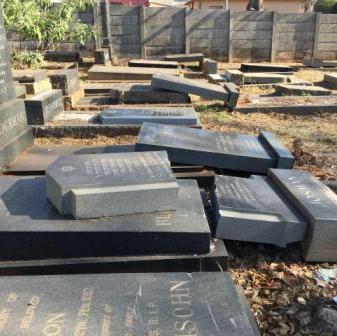click to dowload our latest edition
CLICK HERE TO SUBSCRIBE TO OUR NEWSLETTER


Published
4 years agoon
By
adminTALI FEINBERG
The reconstruction has entailed laying all 66 gravestones flat, at a slight angle in a bed of concrete, and restoring the ones that were vandalised. Then, the paving and walkways needed fixing, and the tahara house – the building where people gather for funerals and bodies are prepared for burials – needed better security. A wall and fence also had to be erected around the cemetery.
Many of the tombstones were broken in half, and some were smashed into smaller fragments and had to be sent to experts to be fixed. The tahara house was broken into twice during the restoration, with the theft of a generator and tools.
In spite of promises from the municipality, it gave little financial assistance, so the project was driven by the Cape South African Jewish Board of Deputies (SAJBD) and community members.
It cost about R12 500 to fix three graves, and the entire project has cost about R310 000 thus far. “The lesson I’ve learnt is that if country communities don’t have a ‘nest egg’ or savings to go towards cemetery maintenance, then we may not be able to restore these cemeteries in future,” said Cape SAJBD Director Stuart Diamond. “We need to engage with communities that still have assets and prepare for the future. Most municipalities are facing critical shortages, and are unable to help.”
Diamond said there were 22 country community cemeteries in the Western Cape. Most gravestones have been laid flat to prevent vandalism, but there are a number that are still upstanding.
Cape Town community member Raymond Schkolne said he assisted in raising funds for the Wellington project after he heard that the restoration of the vandalised stones was taking longer than expected. “My father grew up there, and I have family buried there. My late great-grandmother ran the only kosher guesthouse in Wellington. I have the brass pot that she made jam in!
“My father’s late sister, Ray, who died in a terrible car accident and who I am named after, is buried there. My grandparents built the shul in Wellington, and were the first couple to be married in it. Stories like my great grandfather laying tefillin next to his horse and cart are embedded in my memory. I grew up hearing these stories, and although there is no Jewish community left, I wanted to assist.”
Diamond agrees that those buried in country community cemeteries are an important part of our community’s history “and we need to pay them that respect. Many of them are the first immigrants who came here from Lithuania. They helped build the metros, and brought wealth into the country. This is our chance to ‘pay it back’. Most people don’t know how many Jews reached the interior of the Cape, and how there was some kind of Jewish life in many small towns. We need to ‘future-proof’ this.”
Together with Paarl Jewish community leader Mark Kaufman, Schkolne began contacting the descendants of those buried in Wellington to assist the project financially. The process was slow going, and a lot of the work entailed collecting emails and phone numbers.
It picked up momentum eventually as family members reached out to their own networks, and the response was warm and generous. Schkolne is concerned that the time and effort of such extensive fundraising might be difficult to replicate should other cemeteries be vandalised in future.
“There was no central fund to fund the restoration. The assets that had been sold had mostly been used for other Jewish causes,” he says. “There was a sum donated by the Wellington Community Fund, the rest of which is set aside for future maintenance of the cemetery. In addition, Stellenbosch Shul made a generous donation, and the Paarl and Hermanus Hebrew Congregations also made donations.”
He emphasised that communities must ensure they have enough funds to restore an entire cemetery if needed. Meanwhile, the money raised has been ‘ring-fenced’ into a fund specifically for this project.
Asked why he volunteered his time and resources, Schkolne said it was a “sacred obligation. This was a vibrant, living community. It’s a requirement for people to get involved, both at leadership and grassroots level.”
Diamond paid tribute to Kaufman, who drove the Wellington restoration, and was constantly on site to ensure everything was done correctly, even though it wasn’t his own community. He emphasised that the Cape Board would always prioritise country communities.
“As long as there are still Jews out in the country, we will service them, connect them to their heritage, and help them combat anti-Semitism. We are planning more visits and a continued focus in 2020,” he said.
“We will work closely with the United Orthodox Synagogues and the new Small Jewish Communities Association (SJCA) led by Rabbi Moshe Silberhaft to ensure that these communities get their halachic and rabbinical services. I’m passionate about ensuring that these communities are future-proofed, and it only gets more difficult as time goes by. This is something we need to focus on now.”
